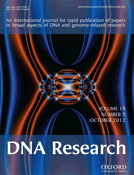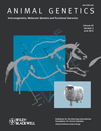
Mitochondrial DNA Part A
Scope & Guideline
Exploring the Genetic Blueprint of Life
Introduction
Aims and Scopes
- Mitochondrial Genome Studies:
Investigating the structure, function, and evolutionary implications of mitochondrial genomes across diverse organisms, contributing to our understanding of genetic diversity and phylogenetic relationships. - Population Genetics and Phylogeography:
Exploring genetic diversity, population structure, and demographic history using mitochondrial DNA, enabling insights into species evolution, conservation, and management. - Species Delimitation and Cryptic Diversity:
Utilizing mitochondrial DNA barcoding and genomic analyses to identify cryptic species and understand species boundaries, which is crucial for biodiversity conservation. - Comparative Genomics:
Conducting comparative analyses of mitochondrial genomes to uncover evolutionary patterns and adaptations among different taxa. - Mitochondrial Disease Research:
Examining the association between mitochondrial DNA variations and human health, particularly in relation to diseases and reproductive biology.
Trending and Emerging
- Mitochondrial Genomics and Phylogenomics:
An increasing number of studies focus on comprehensive analyses of mitochondrial genomes, utilizing phylogenomic approaches to resolve complex evolutionary relationships. - Environmental and Climate Impacts on Mitochondrial DNA:
Research examining how environmental changes and climate factors influence mitochondrial genetic diversity and evolutionary trajectories is gaining traction, highlighting the relevance of mitochondrial studies in ecological contexts. - Human Health and Mitochondrial DNA:
There is a growing interest in the implications of mitochondrial DNA variations in human health, particularly in relation to reproductive health and genetic diseases, which emphasizes the significance of mitochondrial research beyond traditional biological boundaries. - DNA Barcoding for Conservation Efforts:
The application of mitochondrial DNA barcoding for conservation purposes is increasingly prominent, as researchers seek to identify and protect cryptic species and manage biodiversity effectively.
Declining or Waning
- Mitochondrial DNA in Non-Model Organisms:
Research focusing on less common or non-model organisms has decreased, potentially due to a shift towards more widely studied taxa or those with clearer ecological or conservation implications. - Morphological Studies:
The integration of morphological analysis alongside mitochondrial studies has lessened, as the journal increasingly emphasizes molecular techniques and genomic analyses over traditional morphology. - Historical Phylogenetics:
There is a noticeable decline in studies that primarily focus on historical phylogenetics without integrating contemporary genetic data, reflecting a broader trend in evolutionary research towards more dynamic and integrative approaches.
Similar Journals

JOURNAL OF CELLULAR PHYSIOLOGY
Connecting Basic Biology with Clinical InnovationsJOURNAL OF CELLULAR PHYSIOLOGY, published by Wiley, is a leading peer-reviewed journal that has been at the forefront of cellular research since its inception in 1945. With its prestigious Q1 and Q2 rankings in the fields of Clinical Biochemistry and Cell Biology, this journal is highly regarded within the scientific community, reflecting its significant impact factor and rigorous peer-review process. Addressing the intricacies of cell function and physiology, it serves as a crucial resource for researchers, professionals, and students dedicated to advancing knowledge in the life sciences. The journal publishes cutting-edge research articles, integral reviews, and significant findings that bridge basic biology and clinical applications, ensuring access to high-quality scholarly content that informs current practices and future research directions. Although not open access, the journal maintains a rich archive of studies, making it an essential reference point for those invested in the health and biological sciences.

ANTIOXIDANTS & REDOX SIGNALING
Transforming Understanding of Oxidative Stress MechanismsANTIOXIDANTS & REDOX SIGNALING, published by MARY ANN LIEBERT, INC, is a premier journal dedicated to advancing the understanding of oxidative stress, antioxidants, and redox biology in various health contexts. With an impressive track record since its inception in 1999, this journal has continually evolved, currently converging towards 2024 as a core resource for researchers in biochemistry, cell biology, and molecular medicine. It holds a distinguished position in Q1 across several categories, including Biochemistry, Cell Biology, and Clinical Biochemistry, reflecting its critical role in disseminating high-quality research that impacts the fields of physiology and medicine. Despite not being an open-access journal, ANTIOXIDANTS & REDOX SIGNALING is renowned for its rigorous peer-review process and wide reach, ensuring that published articles are both influential and accessible to professionals, academia, and students alike. Researchers can benefit from its comprehensive articles that delve into cutting-edge discoveries and emerging therapies related to oxidative stress and its biological implications.

Human Genomics
Shaping the Future of Molecular Biology and MedicineHuman Genomics, published by BMC, is a leading open-access journal dedicated to advancing the field of genomics and its applications in health and disease. Since its inception in 2003, the journal has provided a vital platform for researchers to disseminate groundbreaking findings related to genetic research, contributing significantly to areas such as Drug Discovery, Genetics, Molecular Biology, and Molecular Medicine, as reflected in its Q1 and Q2 quartile rankings throughout 2023. With an ISSN of 1473-9542 and an E-ISSN of 1479-7364, Human Genomics not only delivers high-quality, peer-reviewed research but also ensures accessibility to a broader audience, empowering professionals, students, and academics to stay at the forefront of genomic science. Through its rigorous editorial standards and impactful publications, the journal fosters a collaborative environment for innovative research across the globe from its base in the United Kingdom. By promoting open access since its launch, Human Genomics continues to enhance the visibility and impact of genetic studies, making it an essential resource for anyone involved in the rapidly evolving field of human genomics.

GENOME RESEARCH
Exploring the Frontiers of Genetic ScienceGenome Research, published by Cold Spring Harbor Laboratory Press, stands as a premier journal in the field of genetics, featuring rigorous peer-reviewed research that explores the complexities of genome organization and function. With an impressive Q1 ranking in both Genetics and Clinical Genetics according to the 2023 category quartiles, this journal effectively bridges the gap between fundamental genetic science and its clinical applications. Its significance is further highlighted by its Scopus rankings, where it ranks #6 out of 99 in Clinical Genetics and #27 out of 347 in Biochemistry, Genetics, and Molecular Biology, showcasing its broad influence and access to cutting-edge discoveries. Researchers and professionals can look forward to a diverse array of articles that cover genomic technologies, bioinformatics, and translational genomics. Although not currently open access, the wealth of information available in each issue makes it an invaluable resource for anyone engaged in genetic research and applications.

DNA RESEARCH
Unveiling the secrets of genetics, one article at a time.DNA RESEARCH is a pioneering open-access journal published by Oxford University Press, dedicated to advancing the field of genetics and molecular biology. Since its inception in 1994, the journal has been at the forefront of scientific innovation, providing a global platform for researchers to publish high-quality findings that drive the understanding of DNA and its implications in medicine. With an impactful presence characterized by a Q2 ranking in Genetics, a Q1 ranking in Medicine (miscellaneous), and a Q2 ranking in Molecular Biology as per the latest 2023 assessments, DNA RESEARCH stands as a vital resource for both established scholars and emerging scientists. The journal's diverse range of articles caters to a wide audience, fostering collaboration and the sharing of knowledge. Researchers, professionals, and students alike will find an abundance of cutting-edge research and insights that can inform their work and further their understanding of this critical scientific domain. For more information and to access articles, visit the journal's website at Oxford University Press.

GENOME
Connecting Researchers to the Heart of GenomicsGENOME is a leading peer-reviewed journal published by Canadian Science Publishing, dedicated to advancing the field of genetics, biotechnology, and molecular biology. With a strong commitment to disseminating high-quality research, GENOME has earned a reputable spot in the academic community, boasting a Q2 classification in Biotechnology and Medicine (miscellaneous), and a Q3 rank in Genetics and Molecular Biology for 2023. The journal, identified by its ISSN 0831-2796 and E-ISSN 1480-3321, publishes innovative studies that span from 1987 to 2024, ensuring a rich historical context while addressing contemporary challenges in the field. Researchers and professionals are encouraged to contribute and engage with content that shapes the landscape of genetic research. Although the journal does not currently provide open access, it remains a vital resource for those committed to the exploration of genomic sciences, making it an essential read for both seasoned researchers and students alike.

RUSSIAN JOURNAL OF GENETICS
Shaping the Future of Genetic UnderstandingRUSSIAN JOURNAL OF GENETICS is a significant platform in the field of genetics, published by PLEIADES PUBLISHING INC since its inception in 1996. With an ISSN of 1022-7954 and an E-ISSN of 1608-3369, the journal focuses on a wide array of topics within genetics, providing researchers, professionals, and students with insights into advancements and discoveries in this ever-evolving discipline. While it currently holds a Q4 ranking in the 2023 Genetics category according to Scopus, representing invaluable opportunities for knowledge dissemination, the journal is actively working to enhance its impact in future rankings. Readers will find the journal a repository of diverse genetic research findings, methodologies, and theoretical advancements. Although it is not an open-access journal, it is committed to serving the academic community through rigorous peer-reviewed articles. With a consistent publication trajectory spanning to 2024, the RUSSIAN JOURNAL OF GENETICS remains a crucial resource for those aspiring to stay at the forefront of genetic research and applications.

Genetics Research
Driving Progress in Genetic and Medical SciencesGenetics Research, published by HINDAWI LTD, is a distinguished open access journal that has been at the forefront of genetic studies since its inception in 1960. With the transition to open access in 2019, this journal has expanded its accessibility, fostering knowledge dissemination across the global scientific community. Operating out of the United Kingdom, it provides a platform for innovative research in the fields of genetics and molecular biology, encompassing a broad range of topics that are highly relevant to medical sciences. As of 2023, it holds a Q4 classification in Genetics and a Q3 classification in miscellaneous Medicine, reflecting its ongoing commitment to scholarly excellence amidst shifting academic landscapes. While the journal's H-index remains unlisted, its indexed ranking within Scopus, with a rank of #325/328 in the Genetics category highlights the challenges ligated to its niche audience. Nevertheless, it serves as a crucial resource for researchers, professionals, and students eager to contribute to and stay informed on the latest genetic research trends and breakthroughs.

ANIMAL GENETICS
Advancing the Frontiers of Animal GeneticsANIMAL GENETICS, published by WILEY, is a leading journal in the fields of Animal Science and Zoology, with a commendable Q1 classification for 2023, reflecting its critical role in advancing research and knowledge in animal genetics. Established in 1986, this journal has become a cornerstone for professionals, researchers, and students alike, providing a platform for innovative research that explores the genetic underpinnings of animal biology. With an ISSN of 0268-9146 and an E-ISSN of 1365-2052, it boasts a significant impact in both agricultural and biological sciences, as indicated by its ranking of #74 out of 490 in its category on Scopus, positioning it in the 85th percentile for Animal Science and Zoology. Readers can access high-quality, peer-reviewed articles that not only illuminate current advancements but also foster future research directions. While currently not an open access journal, ANIMAL GENETICS remains vital for anyone engaged in the exploration of genetics and its applications in medicine and beyond, with a continual commitment to publishing findings that shape the future of animal breeding, conservation, and genetics research.

Genes
Connecting researchers to shape the future of genetics.Genes is a leading open-access journal published by MDPI that focuses on advancing the field of genetics and genomics. Established in 2010 and based in Basel, Switzerland, this journal has made significant strides in promoting innovative research in both clinical genetics and molecular biology. With an impact factor reflecting its relevance and quality, Genes has been classified in the Q2 quartile for Genetics and the Q3 quartile for clinical Genetics as of 2023. The journal provides an accessible platform for researchers, professionals, and students to disseminate their findings and explore emerging trends across the genetics landscape. Accessible online since its inception, Genes allows for continuous engagement and collaboration within the scientific community, fostering a deeper understanding of genetic mechanisms and their implications in health and disease.